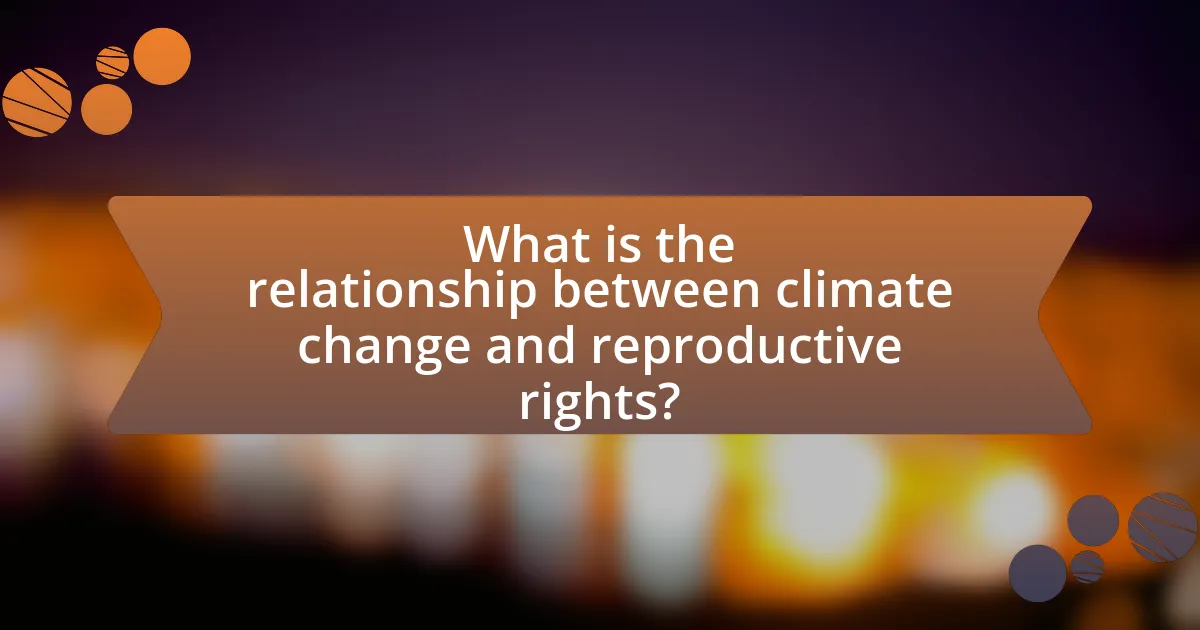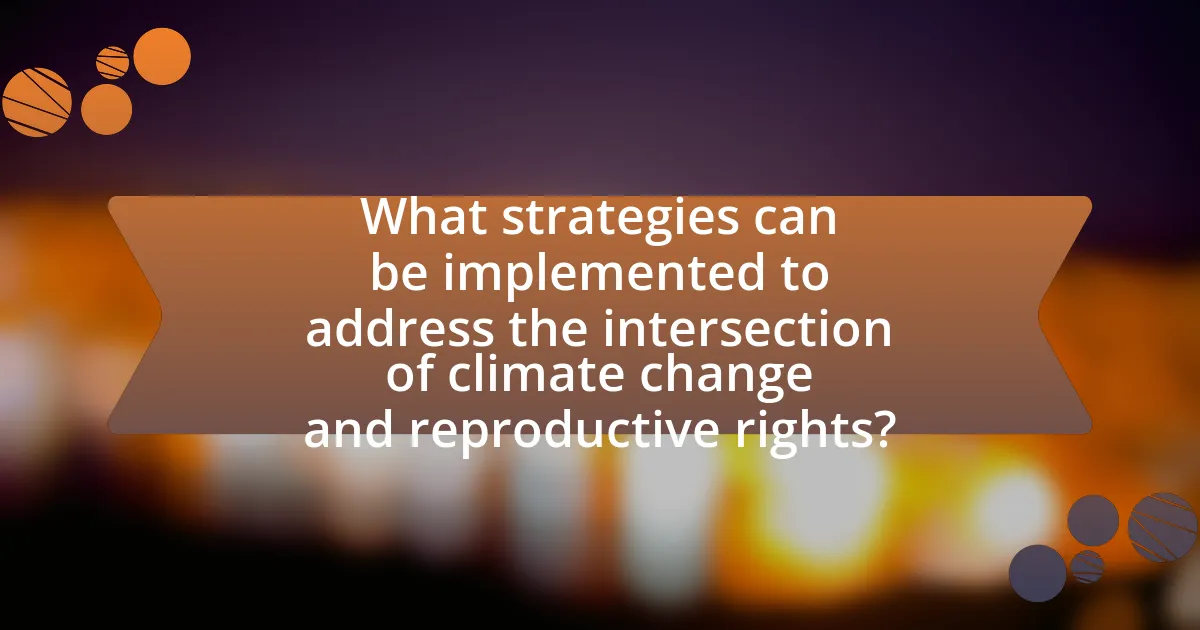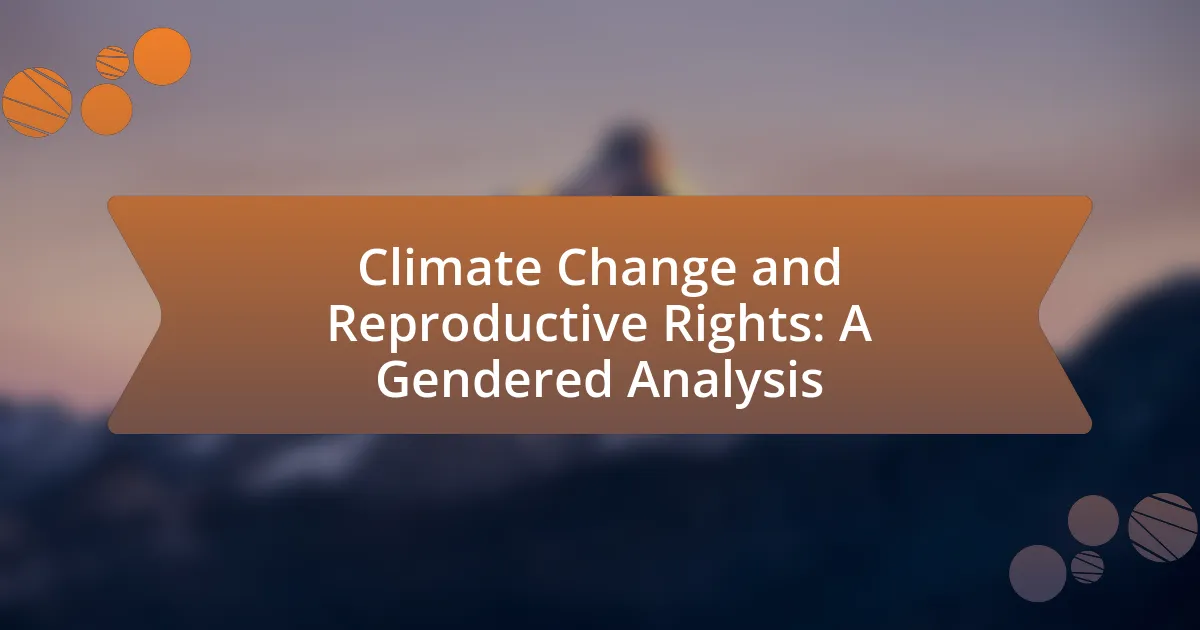The article examines the intersection of climate change and reproductive rights, emphasizing how environmental changes disproportionately affect women’s health and autonomy. It highlights the exacerbation of existing inequalities, increased maternal mortality rates, and limited access to reproductive health services in climate-affected regions. The discussion includes the impact of climate change on reproductive health issues, fertility rates, and the critical role of gender perspectives in shaping policies. Furthermore, it outlines strategies for integrating reproductive rights into climate policies, the importance of community engagement, and the need for gender-sensitive approaches to ensure equitable health outcomes amidst environmental challenges.

What is the relationship between climate change and reproductive rights?
Climate change significantly impacts reproductive rights by exacerbating existing inequalities and limiting access to reproductive health services. As climate-related disasters increase, vulnerable populations, particularly women, face heightened risks to their health and autonomy, including disruptions in healthcare access and increased maternal mortality rates. Research indicates that in regions affected by climate change, such as sub-Saharan Africa, women are more likely to experience unintended pregnancies due to reduced access to contraceptives and family planning services during crises. This relationship underscores the need for integrating reproductive rights into climate change policies to ensure equitable health outcomes and protect women’s rights in the face of environmental challenges.
How does climate change impact reproductive health?
Climate change negatively impacts reproductive health by increasing the prevalence of reproductive health issues such as maternal mortality, infertility, and sexually transmitted infections. Rising temperatures and extreme weather events can lead to food and water scarcity, which in turn affects nutritional status and overall health, crucial for reproductive outcomes. For instance, a study published in the journal “Environmental Research Letters” found that heatwaves are linked to increased rates of preterm births. Additionally, climate change can disrupt healthcare systems, limiting access to reproductive health services, particularly in vulnerable populations. This disruption exacerbates existing inequalities, as marginalized groups often face the greatest barriers to healthcare access during climate-related crises.
What specific reproductive health issues are exacerbated by climate change?
Climate change exacerbates specific reproductive health issues such as increased rates of maternal mortality, complications during pregnancy, and reproductive system disorders. Rising temperatures and extreme weather events can lead to inadequate access to healthcare services, particularly in vulnerable populations, which directly impacts maternal health outcomes. For instance, a study published in the journal “Environmental Research Letters” found that heatwaves are associated with higher rates of preterm births and low birth weight. Additionally, climate change can disrupt food security, leading to malnutrition, which adversely affects reproductive health and fetal development.
How do environmental factors influence fertility rates?
Environmental factors significantly influence fertility rates by affecting reproductive health and behaviors. For instance, exposure to pollutants and chemicals can lead to reproductive health issues, such as hormonal imbalances and infertility. Studies have shown that air pollution is linked to lower fertility rates; for example, research published in the journal “Environmental Health Perspectives” indicates that women exposed to high levels of particulate matter have a higher risk of infertility. Additionally, climate change impacts agricultural productivity, which can lead to food insecurity, thereby affecting family planning decisions and fertility rates. In regions experiencing severe droughts or floods, families may choose to have fewer children due to economic instability and resource scarcity.
Why are reproductive rights critical in the context of climate change?
Reproductive rights are critical in the context of climate change because they empower individuals to make informed decisions about family planning, which directly influences population growth and resource consumption. As climate change exacerbates resource scarcity, access to reproductive health services can help mitigate the environmental impact by allowing families to choose the number and timing of their children. Studies indicate that when women have control over their reproductive choices, it leads to smaller family sizes, which can reduce carbon footprints and alleviate pressure on ecosystems. For instance, the United Nations Population Fund highlights that investing in reproductive health can lead to a decrease in global population growth, thereby contributing to sustainability efforts in the face of climate change.
What role do reproductive rights play in sustainable development?
Reproductive rights are essential for sustainable development as they empower individuals to make informed choices about family planning, which directly influences population growth and resource management. By ensuring access to reproductive health services, including contraception and education, societies can achieve better health outcomes, reduce poverty, and promote gender equality. For instance, the United Nations Population Fund (UNFPA) states that fulfilling unmet needs for family planning could reduce maternal deaths by 70% and contribute to economic growth by allowing women to participate more fully in the workforce. Thus, reproductive rights are integral to achieving sustainable development goals by fostering healthier populations and more equitable societies.
How can access to reproductive health services mitigate climate change effects?
Access to reproductive health services can mitigate climate change effects by enabling individuals to make informed choices about family planning, which directly influences population growth and resource consumption. When people have access to contraception and reproductive health education, they are more likely to have fewer children, leading to reduced demand for resources such as water, food, and energy. For instance, research indicates that if all women who want to avoid pregnancy had access to modern contraceptives, global population growth could be significantly slowed, thereby lessening the strain on the environment and contributing to lower greenhouse gas emissions. This relationship is supported by the United Nations Population Fund, which highlights that investing in reproductive health can lead to sustainable development and environmental benefits.

How do gender perspectives shape the understanding of climate change and reproductive rights?
Gender perspectives significantly shape the understanding of climate change and reproductive rights by highlighting the differential impacts of environmental changes on various genders, particularly women. Women often bear the brunt of climate-related challenges due to existing social inequalities, which can exacerbate issues related to reproductive health and rights. For instance, research indicates that in many developing countries, women are primarily responsible for securing water and food, making them more vulnerable to climate-induced resource scarcity. This vulnerability can lead to increased maternal health risks and limit access to reproductive health services, as seen in studies conducted by the United Nations Population Fund, which emphasize the need for gender-sensitive approaches in climate policies. By integrating gender perspectives, policymakers can better address the unique challenges faced by women, ensuring that reproductive rights are safeguarded in the context of climate change.
What are the gendered impacts of climate change on reproductive health?
Climate change significantly impacts reproductive health, particularly for women and marginalized genders. Increased temperatures and extreme weather events can disrupt healthcare services, leading to reduced access to reproductive health care, including family planning and maternal health services. For instance, a study by the World Health Organization indicates that climate-related disasters can lead to higher maternal mortality rates due to the destruction of healthcare infrastructure and increased stress on health systems. Additionally, climate change exacerbates existing inequalities, as women in low-income communities often face greater barriers to accessing reproductive health services during climate crises. This intersection of gender and climate change highlights the urgent need for gender-sensitive policies in climate adaptation and health strategies.
How do women experience climate change differently than men?
Women experience climate change differently than men primarily due to their roles in society, economic status, and access to resources. Women are often responsible for managing household resources, such as water and food, which makes them more vulnerable to climate-related disruptions like droughts and floods. For instance, in many developing countries, women are the primary caregivers and food producers, and when climate change affects agricultural productivity, it disproportionately impacts their livelihoods and food security.
Additionally, women generally have less access to education and decision-making power, which limits their ability to adapt to climate change. According to the United Nations, women make up 70% of the world’s poor, and their economic dependency can hinder their resilience to climate impacts. Furthermore, climate change can exacerbate existing gender inequalities, leading to increased risks of violence and health issues for women, particularly in crisis situations.
Research from the World Bank indicates that climate change could push an additional 100 million people into poverty by 2030, with women being disproportionately affected due to their socio-economic status. This evidence highlights the distinct ways in which women experience the impacts of climate change compared to men.
What vulnerabilities do marginalized women face in relation to climate change?
Marginalized women face heightened vulnerabilities to climate change due to their limited access to resources, decision-making power, and social support systems. These women often experience increased exposure to climate-related disasters, such as floods and droughts, which can exacerbate existing inequalities. For instance, according to the United Nations, women in developing countries are 14 times more likely than men to die during natural disasters, highlighting their disproportionate risk. Additionally, climate change impacts food security and health, further affecting marginalized women who may lack access to adequate nutrition and healthcare services. This intersection of gender, socioeconomic status, and environmental change underscores the urgent need for targeted interventions to address these vulnerabilities.
Why is a gendered analysis important for policy-making?
A gendered analysis is important for policy-making because it ensures that the distinct needs and experiences of different genders are considered, leading to more equitable and effective policies. This approach recognizes that men, women, and non-binary individuals may be affected differently by policies, particularly in areas like climate change and reproductive rights, where gender roles and responsibilities can influence access to resources and decision-making. For instance, research by the United Nations Development Programme highlights that women are disproportionately affected by climate change due to their roles in agriculture and resource management, which can impact their reproductive health and rights. By incorporating a gendered analysis, policymakers can create targeted interventions that address these disparities, ultimately fostering social justice and improving outcomes for all genders.
How can gender-sensitive policies improve reproductive health outcomes?
Gender-sensitive policies can significantly improve reproductive health outcomes by addressing the unique needs and challenges faced by different genders, particularly women. These policies promote equitable access to healthcare services, education, and resources, which are essential for informed reproductive choices. For instance, research indicates that countries implementing gender-sensitive health policies experience lower maternal mortality rates and improved access to contraceptive methods. A study by the World Health Organization found that gender-responsive healthcare systems lead to better health outcomes, as they consider social determinants of health and empower individuals to make informed decisions about their reproductive health.
What examples exist of successful gender-focused climate policies?
Successful gender-focused climate policies include the Gender and Climate Change Action Plan implemented by the government of Canada, which integrates gender considerations into climate action and aims to empower women in climate resilience efforts. Additionally, the Women’s Environment and Development Organization (WEDO) has advocated for gender-responsive climate policies at international forums, leading to the inclusion of gender equality in the Paris Agreement. These policies are supported by evidence showing that women are disproportionately affected by climate change, and empowering them leads to more effective climate solutions.

What strategies can be implemented to address the intersection of climate change and reproductive rights?
To address the intersection of climate change and reproductive rights, comprehensive strategies must be implemented that include promoting access to family planning services, integrating reproductive health into climate policies, and enhancing education on the impacts of climate change on reproductive health. Access to family planning services empowers individuals to make informed choices about reproduction, which is crucial in regions affected by climate change, where resources may be limited. Integrating reproductive health into climate policies ensures that the unique needs of women and marginalized groups are considered, as they are often disproportionately affected by both climate change and reproductive health issues. Furthermore, education initiatives can raise awareness about how climate change affects reproductive health, thereby fostering community resilience and informed decision-making. These strategies are supported by research indicating that improved reproductive health services can lead to better health outcomes and increased resilience in the face of climate challenges.
How can education and awareness campaigns promote reproductive rights in the context of climate change?
Education and awareness campaigns can promote reproductive rights in the context of climate change by informing communities about the intersection of environmental issues and reproductive health. These campaigns can highlight how climate change disproportionately affects vulnerable populations, particularly women, by increasing health risks related to pregnancy and access to reproductive services. For instance, research indicates that climate-related disasters can disrupt healthcare systems, leading to reduced access to contraceptives and maternal care, which directly impacts reproductive rights. By raising awareness of these challenges, campaigns can empower individuals to advocate for policies that protect reproductive health in the face of climate change, thereby fostering a more equitable response to both environmental and reproductive health crises.
What role does community engagement play in these campaigns?
Community engagement is crucial in climate change and reproductive rights campaigns as it fosters awareness, mobilizes support, and amplifies marginalized voices. Engaging communities allows for the incorporation of local knowledge and experiences, which enhances the relevance and effectiveness of campaign strategies. For instance, research shows that grassroots movements, which rely heavily on community involvement, have been instrumental in advocating for policies that address both climate change and reproductive health, leading to more equitable outcomes. This participatory approach not only empowers individuals but also builds a collective identity that strengthens advocacy efforts, as evidenced by successful initiatives in various regions that have effectively combined environmental and reproductive rights agendas.
How can technology be leveraged to improve access to reproductive health information?
Technology can be leveraged to improve access to reproductive health information by utilizing mobile applications, telemedicine, and online platforms that provide reliable resources and services. Mobile applications can offer personalized health tracking, educational content, and direct communication with healthcare providers, making information more accessible to individuals regardless of their location. Telemedicine allows patients to consult with healthcare professionals remotely, which is particularly beneficial in areas with limited access to reproductive health services. Online platforms can aggregate and disseminate evidence-based information, ensuring that users receive accurate and up-to-date resources. For instance, a study published in the Journal of Medical Internet Research found that mobile health interventions significantly increased knowledge and access to reproductive health services among users, demonstrating the effectiveness of technology in this domain.
What best practices can be adopted to ensure reproductive rights are protected amidst climate change?
To ensure reproductive rights are protected amidst climate change, integrating reproductive health services into climate adaptation strategies is essential. This approach acknowledges the intersection of climate impacts and reproductive health, ensuring access to family planning, maternal care, and sexual health services even in crisis situations. For instance, the World Health Organization emphasizes that climate change can exacerbate health inequities, making it crucial to maintain reproductive health services during environmental disasters. Additionally, promoting education on reproductive rights and climate resilience can empower communities, particularly women, to make informed choices about their reproductive health in the face of climate challenges.
How can healthcare systems adapt to the challenges posed by climate change?
Healthcare systems can adapt to the challenges posed by climate change by integrating climate resilience into their operational frameworks. This includes developing emergency preparedness plans that account for climate-related health risks, such as heatwaves and natural disasters, which can exacerbate health issues. For instance, the World Health Organization emphasizes the need for health systems to strengthen their capacity to respond to climate-induced health emergencies, which can include increasing access to healthcare during extreme weather events. Additionally, healthcare systems can implement sustainable practices, such as reducing carbon footprints and promoting telehealth services, which can mitigate the impact of climate change on healthcare delivery. Evidence from the Lancet Countdown on Health and Climate Change indicates that proactive adaptation strategies can significantly reduce health risks associated with climate change, thereby improving overall public health outcomes.
What policies should be prioritized to support reproductive rights in vulnerable communities?
Policies that should be prioritized to support reproductive rights in vulnerable communities include comprehensive sex education, access to affordable contraception, and the protection of abortion rights. Comprehensive sex education equips individuals with knowledge about reproductive health, reducing unintended pregnancies and sexually transmitted infections. Access to affordable contraception ensures that individuals can make informed choices about family planning, which is crucial in communities facing economic and social challenges. Protecting abortion rights is essential for safeguarding women’s autonomy over their bodies, particularly in areas where climate change exacerbates existing inequalities, leading to increased vulnerability. Studies show that when reproductive rights are upheld, communities experience improved health outcomes and greater economic stability, highlighting the importance of these policies in fostering resilience against climate-related challenges.
What practical steps can individuals take to advocate for reproductive rights in the face of climate change?
Individuals can advocate for reproductive rights in the face of climate change by engaging in community education and awareness campaigns. These campaigns can highlight the intersection of reproductive health and environmental issues, emphasizing how climate change disproportionately affects marginalized communities. For instance, studies show that climate-related disasters can lead to increased rates of maternal mortality and limited access to reproductive healthcare services. Additionally, individuals can support policies that promote reproductive health access and environmental sustainability, such as advocating for comprehensive sex education and funding for reproductive health services in climate-affected areas. By participating in local advocacy groups and leveraging social media platforms, individuals can amplify their voices and influence public policy to ensure that reproductive rights are prioritized in climate action discussions.
